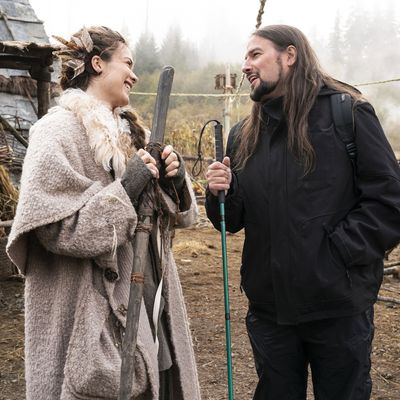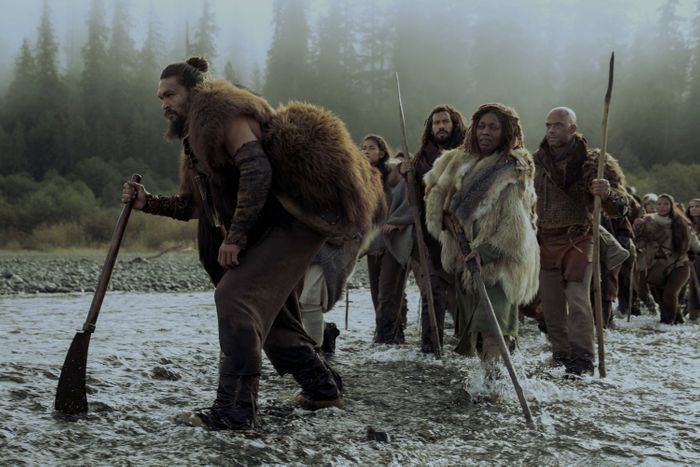
You can’t make a show about a world without vision without first understanding what it’s like to be blind. See, the big, sprawling flagship science-fiction series on Apple’s new subscription service Apple TV+, is set hundreds of years in the future, well into the aftermath of an epidemic that devastated the global population and left Earth’s last million-odd survivors totally blind. Sight was lost so many generations ago that it exists now only as the vaguest myth, considered by those in power a dangerous heresy; the world, primitive and tribal, is built to navigate without vision, designed instead for hearing and touch. The characters talk, plan, love, fight, scheme, and betray with just their four remaining senses. Naturally, how they get by without the fifth is the most intriguing thing about the show — and that’s where Joseph A. Strechay, an associate producer and “blindness consultant” on the series, comes in.
Strechay likes to say that Apple changed his life. A professional consultant for disability employment and movies and TV shows that concern the visually impaired, Strechay is a dedicated advocate for accessibility — and in his own life, he says, accessible features on devices like the iPhone and the iPad have had an enormous impact on his day-to-day experience with the world. So it’s only fitting that Strechay should offer his expertise to Apple as they embark on a new, unconventional project that has blindness and accessibility at its core.
From the beginning, for Apple, for the showrunners, and for the cast and crew, it was critical to approach the concept and the material with respect and sensitivity, as well as a basic curiosity about life for the visually impaired. To that end, Strechay’s involvement was not a matter of simple fact-checking or confirmation that the show wouldn’t offend anyone. Strechay collaborated with executive producers Jon Steinberg and Dan Shotz on the writing and overall direction of the material. He also joined the crew on set, making suggestions for tweaks to performances when he had ideas of how things could be portrayed more accurately to the experience of the blind. What’s more, Strechay was instrumental in ensuring that the set was accessible to everyone: In a bid for diversity and inclusion, many blind or low-vision actors were brought in to join the cast, and Strechay advised production on how to accommodate their needs. “When we went to some of the most complicated and inaccessible locations you can imagine … the first question was how do we make this work for Joe, [or] for our cast members with low vision,” explains Shotz.
For showrunner Stephen Knight, working with people who had experienced what his series was about was an obvious route from the start. Though he admits that, at the end of the day, they’re “creating an entertainment,” it was essential in creating the world and fashioning the details “for it to be right.” A lot of the time, that came down to simply trying to develop a better understanding. “We talked to a lot of people with blindness or low vision. People who were born blind, which is a different thing. And we just asked the questions that you normally don’t ask because you feel it’s impolite.”
This interest ranged from the philosophical to the strictly mechanical — from “the physical, practical questions” to “what are your dreams like,” Knight explains. “We spoke to a couple who were born blind, who were very much in love. They had a nice life together in the midwest. I asked them, if they could take a tablet right now that would enable them to see, would they take it? And they both said no immediately. No question.” It was conversations like these, Knight insists, that made him feel comfortable bringing this idea to life.
The cast of See, meanwhile, had their own learning to do. “I discovered a lot of things on this by not using sight — by heightening our other senses, which are usually quite dulled down,” says Jason Momoa, who stars as the taciturn, musclebound pack leader Baba Voss. Like the rest of the ensemble, Momoa underwent an astonishingly extensive training program in pre-production on the show, one designed to initiate the actors, however cursorily, into the world of the visually impaired. “I learned a lot. It changed my whole performance,” Momoa says. “You find out all these cool things. Touch and feel and smell. It was extremely beautiful. And I’m a lot more alert to my wife now.”
Blindness “bootcamp,” as the cast and crew referred to it, was intensive for a TV project of this kind — so intensive, in fact, that almost every actor on the show I spoke to swore that it changed their entire perspective on vision and the blind. In collaboration with Strechay, the actors learned passive and active echolocation, peripheral viewing, eccentric vision, blindness orientation, sensory training, and movement training. They learned firsthand from members of the blind and low-vision community, working out how to look at other people and how to move. “Having so many blind and low-vision actors working with us was such a privilege,” says Yadira Guevera-Prip, who stars on the show as Bow Lion. “We were demystifying so many of the things we all had assumptions about.”
Hera Hilmar, who plays Baba Voss’s wife Maghra, was surprised most of all by how much the blind can do. “I know this sounds silly,” she says, “but I learned how capable blind and low-vision people are. There are actors on our team who play basketball. I just didn’t know that you can be as physically capable as so many people are. I found it amazing.” Strechay himself is quick to point out how common this really is: “There are people who are blind who are judo champions,” he says. “A buddy of mine is a mountain climber and has summited Everest.”
One of the most effective exercises undertaken by the cast, to hear them tell it, was also one of the simplest: They were instructed to wear ordinary household sleep masks, in some cases for hours at a time, every day. “As a sighted person, I don’t actually know what it’s like to be blind,” says Guevera-Prip. “But I spent a lot of time under sleep shades, four or five hours a day, feeling the world that we live in. It was a wonderfully engaging and exciting experiment. We’re visual creatures. So taking that away was a beautiful challenge.”
The sleep masks could be so intensive that some actors couldn’t handle it. “I could only stay in my sleep shade for about ten minutes at a time,” explains Alfre Woodard, who co-stars alongside Momoa as Paris, a wise matriarchal figure. “I have really acute hearing and a great nose. After ten minutes, I start to giggle, and then I have to leave. I get overstimulated.” The blindness, Woodard says, was “a language I didn’t know,” one she had learn, the same as any other. “I didn’t even know there was a language, that was the thing,” she says. “Doing the blindness training, and trying to tell a story as a blind person, I think you come up with some of your best acting, because you’re not relying on what you see.”
The production’s focus on accessibility was unusually comprehensive. It wasn’t simply a matter of casting some blind people and getting the sighted actors up to speed: It was important to the producers, and of course Strechay, for everything to be as accessible as possible all the way down. Scripts were made available in braille and as audiobooks; considerations were made by the production-design team to provide a more consistent, and therefore more easily navigable, set for actors who are blind or low vision. Accessibility was a major factor on the backend, too: See is available with subtitles for the deaf or hard-of-hearing in more than 40 languages, and with audio descriptions for the visually impaired in nine languages. The audio descriptions are even available in Dolby Atmos, a first in the industry.
“We really made an effort with this show,” Strechay says. “And it’s really modeled after Apple’s philosophy on accessibility.” Apple at large has always been vocal about prioritizing accessibility, describing it as one of the company’s core values. Indeed, Sarah Herlinger, Apple’s Global Accessibility Chief, says that their efforts in this field are about “viewing accessibility as a basic human right,” whether that pertains to the settings on a smartphone or the treatment of blindness on a TV show. “The overarching way that we approach it, regardless of what product or service, is with respect — treating people respectfully, and taking their needs into consideration as we design.”


